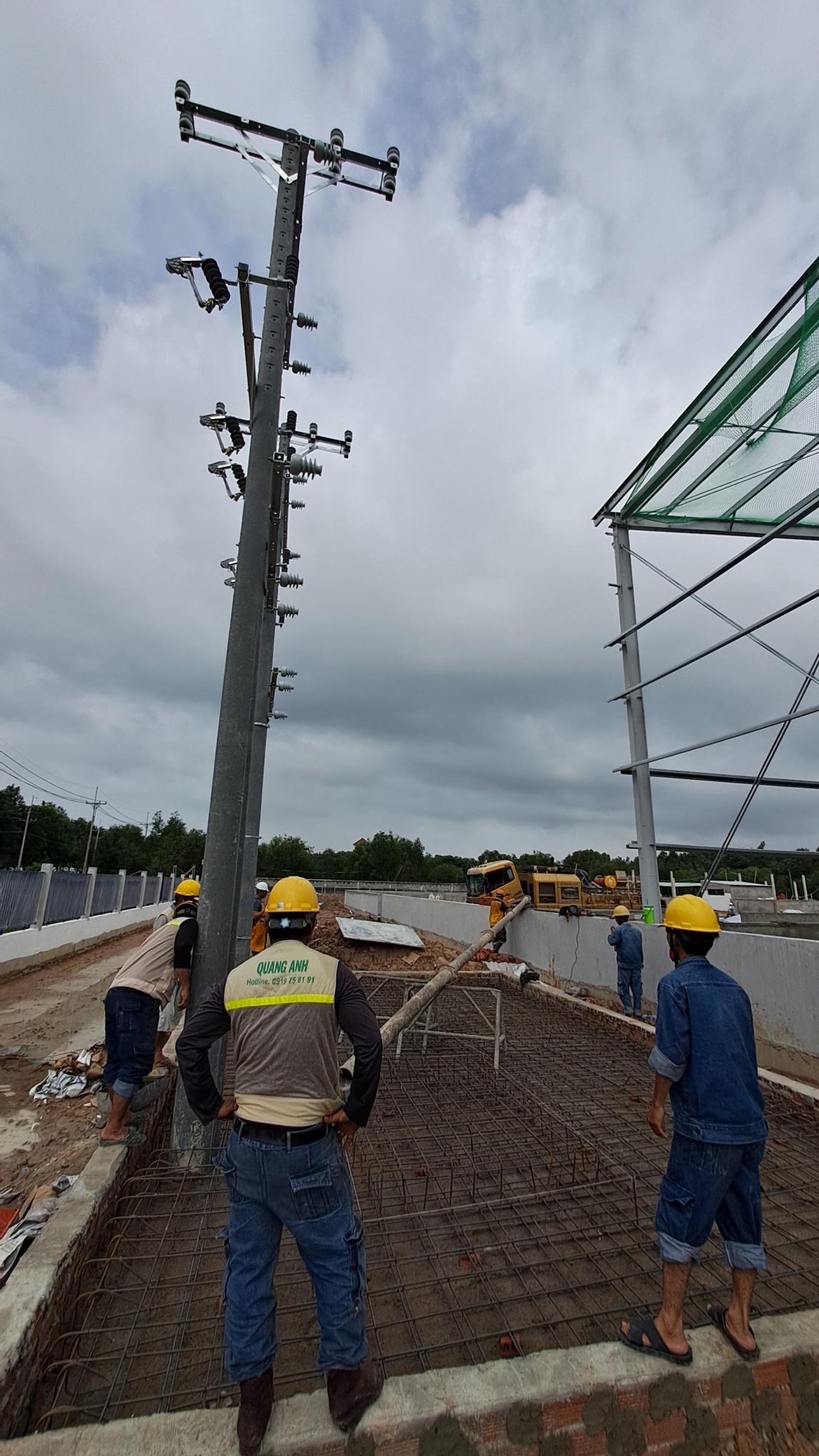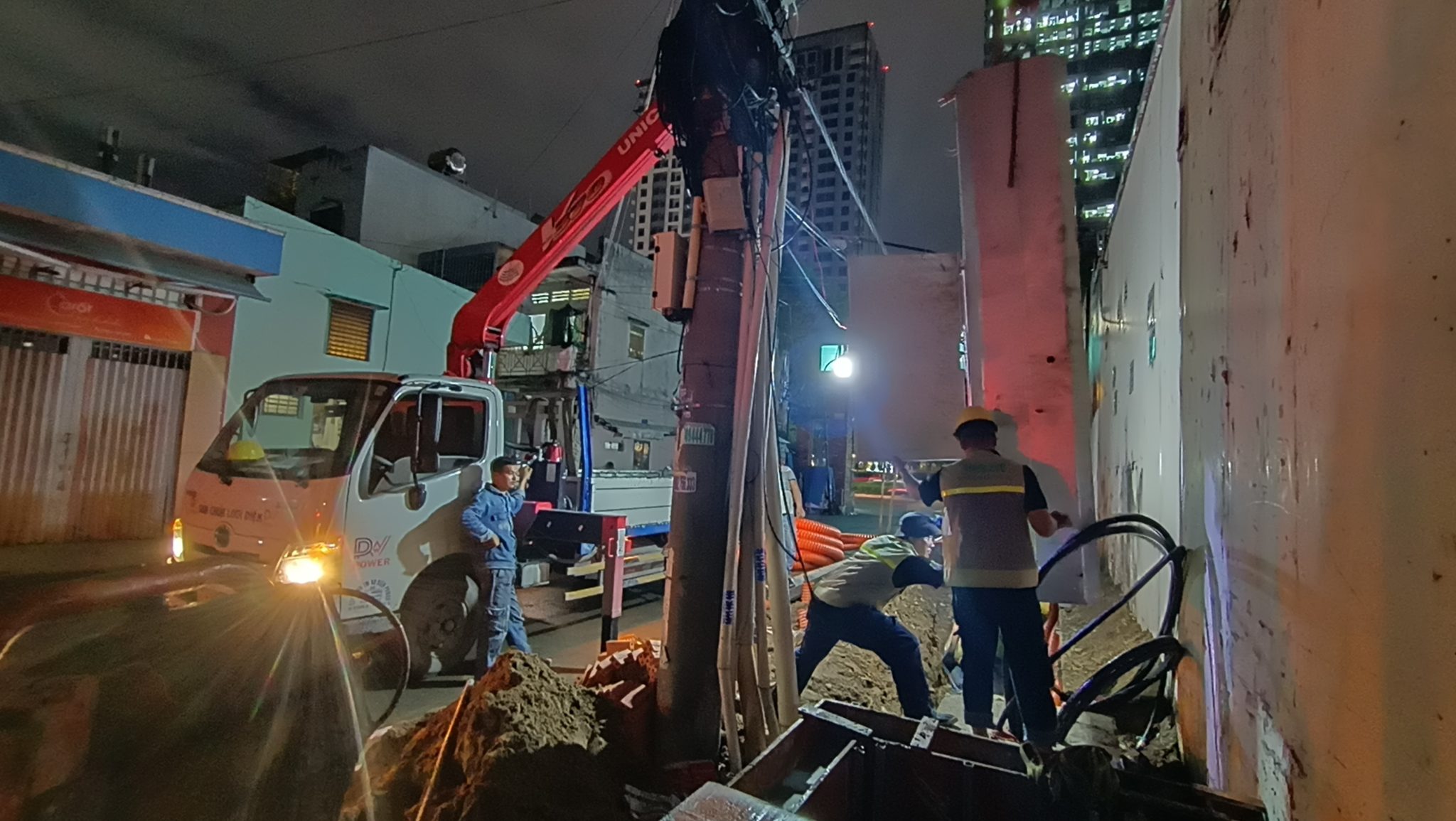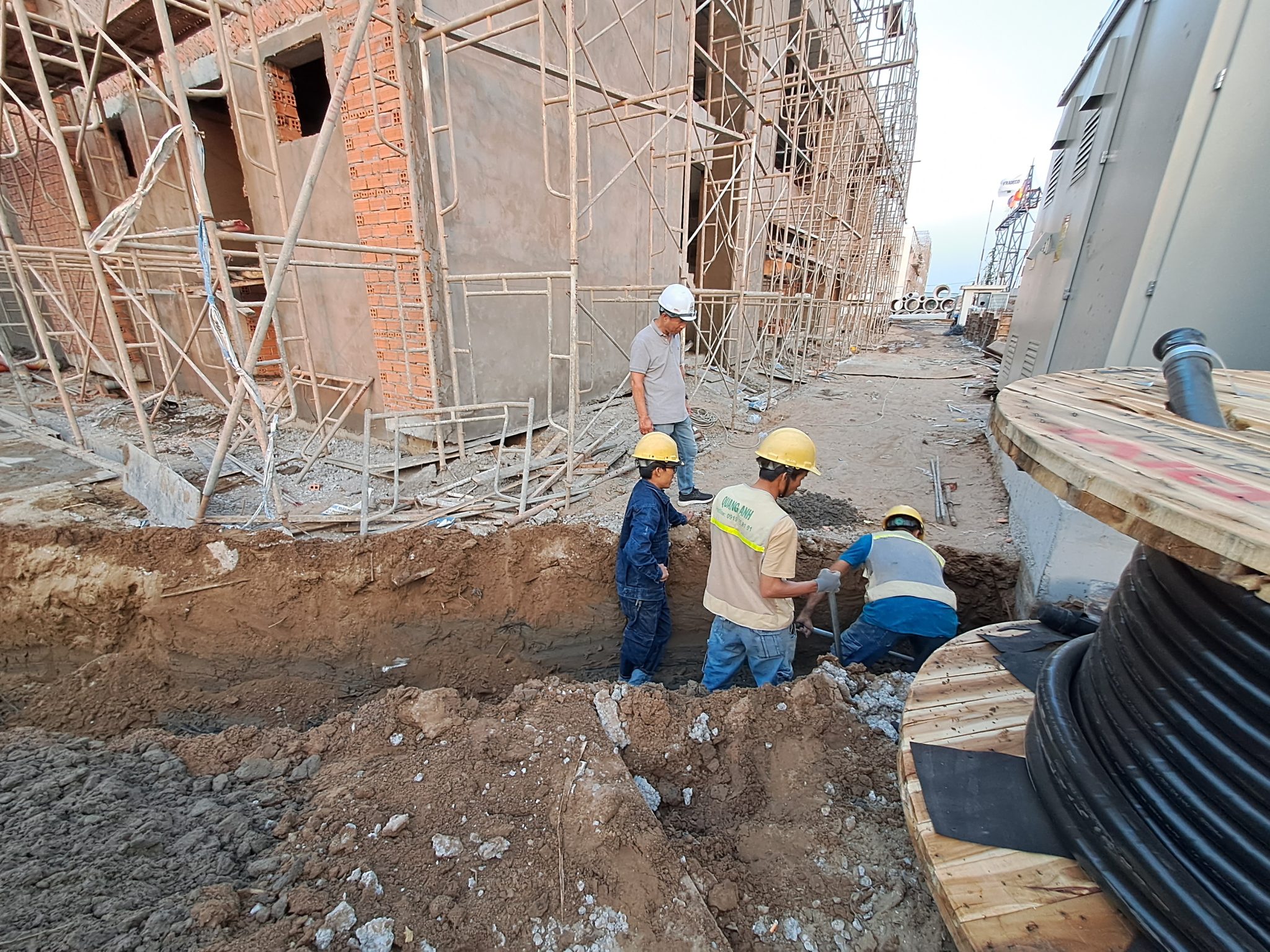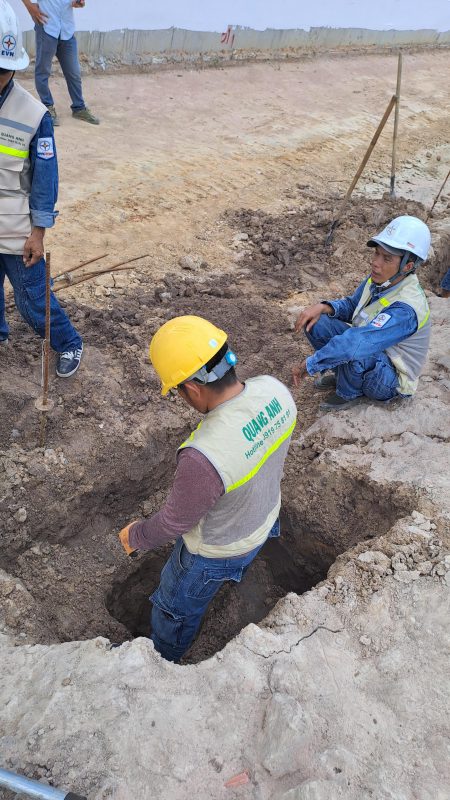Quanganhcons excels in industrial electrical system execution and substation projects, providing comprehensive EPC services for medium to low voltage grids and underground systems, leveraging innovative technologies like robotic drilling.
Service Scope and Technical Capabilities in Industrial Electrical Construction
At QuangAnhcons, we offer full EPC services from 35 kV substations to underground and rooftop solar systems. Our turnkey solutions in industrial electrical installations cover both overhead and underground lines. Using cutting-edge technologies like robotic drilling and trenchless methods, we ensure timely and quality project completion.
The range and technical expertise are crucial for gaining reliability and success in the construction and energy markets. Particularly for EPC industrial electrical projects, a contractor must provide comprehensive services from design to execution, operation, and maintenance.
A technical service provider’s scope includes activities like design consultancy, system installation, medium voltage line management, and advanced execution solutions. Technical capabilities are pivotal, contingent on the quality of personnel and necessary professional certifications.
- Definitions and Classifications
- The service scope in industrial electrical often includes:
- Technology capability assessment.
- Supporting technological innovation roadmap development.
- Executing end-to-end electrical systems, from design to maintenance.
- Utilizing advanced construction technology like trenchless robotic drilling.
- Technical capability entails skilled personnel, standard processes, and advanced equipment.
- Legal Standards
- Document No. 21/2023/TT-BKHCN acts as a reference on economic-technical norms for services using state budgets, vital in defining service scope and technical capabilities.
- Components Describing Service Scope and Technical Capability
- A clear service list, detailing tasks and deliverables.
- Criteria quantification for capability: engineers, technicians, equipment.
- Technical Capability Assessment Method
- Assessment process involves collecting records, preliminary and professional evaluation, on-site inspection, and references from previous projects.
- Practical Application
- Example: For electrical system installation services, design engineers, fully certified execution teams, and robust safety management are essential.
- Risk and Management Measures
- Risks may arise from unclear scope descriptions, inadequate team capabilities, and poor safety management. Management measures include capability proof, stage acceptance checks, and continuous workforce training.
Strict standard adherence and the successful execution of an industrial electrical EPC project hinge on fully exploiting advanced technical capabilities and comprehensive service scope.

Process and Standards for Quality Safety
QuangAnhcons emphasizes strict adherence to safety standards and commits to the highest quality levels. Their construction process spans design, ground reinforcement, and heat-resistant material use, ensuring durability and safety for underground systems. They also publicly share quality certifications like ISO, affirming credibility and reliability.
Quality and safety compliance in construction is indispensable through applying quality safety standards. Quality management processes are realized from planning quality, inspecting materials, supervising construction to acceptance, handover, and recordkeeping. This lays the foundation for continuous compliance and quality management improvement.
Quality Management Process
- Quality Planning: Involves setting objectives, scope, and applicable standards to plan clear inspections, assign responsibilities, and schedule checks.
- Material Survey and Inspection: Gathering design, construction, and completion records and surveying and collecting material quality documents.
- Construction Monitoring: Ensures approved construction processes are followed, oversees work safety, and manages execution measures.
- Testing and Certification: Includes non-destructive testing and sampling to analyze material quality and components against technical standards.
- Acceptance and Recordkeeping: Acceptance of phases and entirety, storing reports and quality records as required.
Legal and International Standards
Vietnam applies systems like TCVN/QCVN alongside international standards such as ISO to regulate and guide safety and quality criteria. ISO 9001, for instance, is a quality management standard helping organizations establish control and improvement systems.
Technical and Safety Quality Content
Metrics like material origin, quality certifications, concrete strength, steel structure, and weld inspections, and electrical systems are rigorously checked against safety and quality standards.
Inspection and Testing Methods
Methods like non-destructive testing (NDT), sampling experiments, and real-time monitoring play an important role in project assessment and certification.
Roles and Responsibilities
Every stakeholder from investors, contractors, inspection parties to state agencies plays a crucial role in ensuring construction project quality and safety.
Documentation and Reporting
A full AQL process requires preparing and maintaining design records, inspection logs, certification reports, and comprehensive acceptance documents.
Construction Safety Risk Management
This includes creating safety plans, risk analysis, and detailed preventative measures, alongside training and equipping personnel with personal protective equipment.
Supportive Tools and Techniques
Quality management systems like QMS under ISO, project management software, and BIM tools effectively support quality and design conflict management.
Best Practices
Proposed best practices include detailed quality planning, source inspections, and independent certifications, along with digitizing records and regularly evaluating workforce capability.

Advantages of Modern Construction Technology
QuangAnhcons employs advanced technologies such as AI-integrated management and trenchless methods for underground cables, minimizing impact on the surroundings. Robotic drilling technology is widely used, ensuring optimal and safe industrial electrical project execution.
As modern construction technology advances, adopting technologies like 3D printing, automation, and AI project management increasingly reveals its superior advantage. A clear benefit is expedited construction timelines through modern methods like prefabrication, precast, and equipment automation, reducing time compared to traditional methods.
The quality and material control plays a vital role by producing components in factories, such as precast or Acotec panels, allowing better control over surface quality and dimensions, reducing plastering needs, and maintaining flatness and other technical standards.
Additionally, labor cost reductions through automation and lightweight, pre-processed materials have decreased the workforce requirement on site, leading to management and capital cost savings as construction time significantly shortens.
In sustainable construction, new execution technologies also reduce waste and environmental impact through 3D printing and material optimization, coupled with recycled materials, recycled concrete, and bio-plastics. These technologies contribute to sustainable construction, reducing material waste and improving environmental efficiency.
Labor safety is also elevated through machinery and robot automation, reducing direct on-site labor and thus diminishing labor accident risks. With advanced technologies like BIM, AR/VR, and automated locating systems, execution is not only more precise but also reduces design errors.
The practical application of modern construction technology is varied, from using 3D printing for complex designs to integrating BIM technology for effective AI project management. These technologies enhance construction processes and open new design possibilities with high flexibility.
However, deploying modern technologies requires significant initial investment in machinery and workforce training, along with changes to processes and technical standards, demanding new legal frameworks and execution standards. Logistics and supply chain issues must also be addressed to fully capitalize on these technological benefits.

QuangAnhcons offers superior technical benefits, assuring quality and timeliness in energy projects. Their investment in advanced construction technology and high safety standards establishes a competitive edge.
Contact QuangAnhcons now via Hotline: +84 9 1975 8191 for comprehensive industrial electrical solutions.
QuangAnhcons provides design, construction, and maintenance services for industrial electrical systems, substations up to 35 kV, and renewable energy solutions with the highest quality standards.
[contact-form-7 id="7239967" title="Contact form 1"]


Related Posts
Tay Ninh Solar Power Planning: Technical Framework, Grid Interconnection, and Rollout Roadmap
Technical overview of solar planning in Tay Ninh: irradiation, grid capacity, permitting, design, operations, and [...]
Dec
Binh Duong Solar Planning: Regulatory Framework, Grid Interconnection, and an Implementation Roadmap for Factories and Industrial Parks
An overview of Binh Duong solar planning: legal framework, interconnection, design, risk management, and an [...]
Dec
Solar Farm Repair: O&M Workflow, IV Curve Diagnostics, Thermography, Inverter Service and Utility-Scale Safety
A utility-scale solar farm repair plan centered on O&M, IV curves, thermal imaging, inverter service, [...]
Dec
Dong Nai Solar Power Plan 2023–2025: Tri An 1,029 MW, Grid Upgrades and the DPPA Pathway
A complete look at Dong Nai’s solar power plan: Tri An 1,029 MW, irradiation potential, [...]
Nov
Quang Ngai Solar Power Plan 2024–2030: Legal Framework, Irradiance Potential, and Development Roadmap
A complete look at Quang Ngai’s solar power plan: capacity targets, irradiance (PVout), development zones, [...]
Nov
Solar Damage Assessment Services: On-Site Procedures, EL/IV/Thermography Testing & Compliance with Standards
Discover IEC/UL/NEC standard solar damage assessment processes: on-site evaluation, EL and IV curve testing, thermal [...]
Nov
Comprehensive Package Estimate for a 1800MVA 500kV Substation: Scope, Configuration 3x600MVA, Standards and Timeline Management
An overview of the 1800MVA 500kV substation estimate: construction scope, configuration 3x600MVA, GIS/AIS, SCADA, standards, [...]
Nov
Factory Electrical Systems: Comprehensive Design and Implementation Guide
Discover the detailed and safe process of factory electrical systems design and implementation. [...]
Oct
Blueprints Required for Factory Construction Permits
Discover the necessary blueprints in factory construction permit applications, from floor plans to electrical and [...]
Oct
What Are the Requirements for a Factory Construction Permit? A Comprehensive Guide
Explore the documentation and steps needed to secure a factory construction permit for streamlined project [...]
Oct
Factory Construction Permit Procedures in Vietnam: Essential Guidelines and Documents
Learn the procedures for securing a factory construction permit in Vietnam, focusing on document preparation [...]
Oct
Key Steps in the Factory Construction Process
Discover the essential steps and requirements for building factories. [...]
Oct
Comprehensive Electrical Substation Solutions by Quanganhcons
Discover the cutting-edge electrical substation solutions offered by Quanganhcons for industrial applications. [...]
Oct
Investment Costs for a 1MWp Solar Power System and Influencing Factors
Explore the investment costs for a 1MWp solar power system in Vietnam and the influencing [...]
Sep
QuangAnhcons: Elevating Wind Energy Solutions
Explore QuangAnhcons' leadership in wind energy and renewable solutions in Vietnam. [...]
Sep
Electrical Contractor Strategies at Becamex Industrial Park
Discover the strategic advancements and partnerships of the electrical contractor at Becamex Industrial Park. [...]
Sep
Investment Insights for 1MW Wind Energy in Vietnam: Costs and Opportunities
Discover the detailed analysis of costs and opportunities for investing in 1MW wind energy projects [...]
Sep
Advanced Electrical Installation Solutions by QuangAnhcons
Explore advanced electrical installation solutions and modern technology with QuangAnhcons. [...]
Sep
Enhancing Industrial Electrical Services with Quanganhcons
Discover Quanganhcons' expertise in industrial electrical services, offering efficient and sustainable power systems. [...]
Sep
Comprehensive MEP Solutions by QuangAnhcons: From Design to Maintenance Excellence
Discover optimal MEP solutions with QuangAnhcons, dedicated to excellence from design through maintenance. [...]
Sep